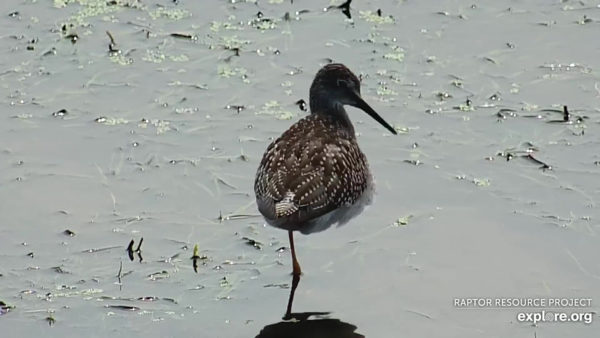Information About The Bird
Seen/Heard at
Mississippi River Flyway
Diet
Greater Yellowlegs eat primarily aquatic and terrestrial invertebrates, small fish, and frogs. They are visual hunters that forage in shallow water by stabbing at prey they can see, scything their bills from side to side for prey they can’t see, or running and lunging to catch larger animals like fish and frogs. Three stomachs taken during fall migration in Illinois contained 60.3% dragonfly naiads, 16.7% diving beetle adults and larvae, 9.7% minnows, 8.3% snails, 3.3% soldier fly larvae, 1% seeds, and a smidgen of water boatmen and earthworms.
Nesting
Greater Yellowlegs nest from the beginning May through mid-July. Very little is known about their nesting behavior, although we believe they make shallow scrapes in the ground and prefer to nest near stands of tall vegetation if possible. Females lay one clutch of three to four grey, olive, or brownish eggs. Males and females have been seen guarding newly hatched precocial young, but we don’t know whether males participate in brooding. Why do we know so little about Greater Yellowlegs? They are small, secretive birds that breed in the northern tundra: remote, vast, and very difficult to access even during its brief summer. Perhaps new tracking technologies will help us learn more.
Citations and attributions
Digital Distribution Maps of the Birds of the Western Hemisphere, version 1.0. NatureServe, Arlington, Virginia, USA. Data provided by NatureServe in collaboration with Robert Ridgely, James Zook, The Nature Conservancy – Migratory Bird Program, Conservation International – CABS, World Wildlife Fund – US, and Environment Canada – WILDSPACE.
Web Link: http://bit.ly/2ynPQ5I
The Cornell Lab of Ornithology Birds of North America: https://www.allaboutbirds.org/guide/Greater_Yellowlegs/lifehistory
Birds of North America: https://birdsna.org/Species-Account/bna/species/greyel/introduction
General Description
Migration
Measurements
Wing Design
| See also different: | Mississippi River Flyway, Sandpipers and Phalaropes and Allies |
